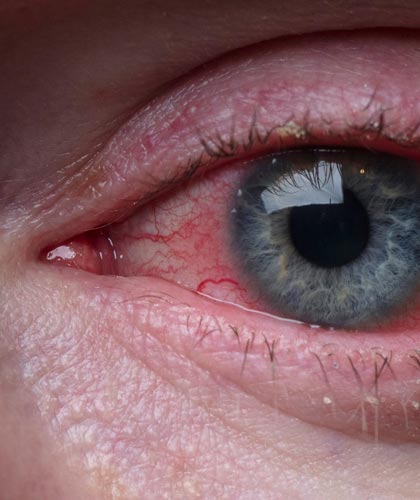Allergic Conjunctivitis: How Mold Affects Your Eyes
Mold and allergic conjunctivitis share a significant relationship, as mold exposure can trigger and exacerbate allergic conjunctivitis symptoms. Understanding the connection between mold and allergic conjunctivitis is crucial in managing and preventing this condition effectively.
What is Allergic Conjunctivitis?
Allergic conjunctivitis is one type of pinkeye. It occurs as a result of an allergic reaction to certain substances, known as allergens, that come into contact with the eye.
Common allergens that can trigger allergic conjunctivitis include pollen, dust mites, pet dander, mold spores, and certain medications.
Is Allergic Conjunctivitis Caused by Mold?
While allergic conjunctivitis can be caused by various allergens, including mold spores, it isn't always the sole cause. Allergic conjunctivitis may be triggered by various types of allergens.
What are The Symptoms of Allergic Conjunctivitis Caused by Mold?
If you suspect you have allergic conjunctivitis or are experiencing persistent eye symptoms, it is recommended to consult an eye care professional for an accurate diagnosis and appropriate treatment.
The mold health effects of allergic conjunctivitis can vary but often include:
- Redness and itching of the eyes
- Watery or teary eyes
- Swelling and puffiness of the eyelids
- Sensation of grittiness or foreign body in the eye
- Blurred vision
- Light sensitivity
Mold-Induced Allergic Conjunctivitis Treatment
It's important to consult with an eye care professional or allergist for a proper diagnosis and personalized treatment plan. They can evaluate the severity of your condition and recommend the most appropriate treatment options for your mold-induced allergic conjunctivitis.
Here are some treatment options that may be recommended:
- Avoidance of Mold: Limiting exposure to mold is crucial if mold has been identified as the primary cause. A professional mold removal company will need to be contacted in order to inspect the areas of concern, as well as address any issues. Identify and remove the source of mold in your environment, such as damp areas, water leaks, or areas with high humidity. Use dehumidifiers, fix any leaks promptly, and ensure regular mold inspections are performed.
- Antihistamine Eye Drops: Prescription antihistamine eye drops can be effective in reducing itching, redness, and other symptoms related to a mold allergy.
- Mast Cell Stabilizers: These eye drops help prevent the release of histamine and other allergy-inducing substances from mast cells in the eye. They are often used as a preventive measure before exposure to mold or other allergens.
- Non-Steroidal Anti-Inflammatory Drugs (NSAIDs): NSAID eye drops, which can be available over-the-counter or by prescription, can help reduce inflammation and relieve redness and swelling.
- Corticosteroid Eye Drops: In some severe cases corticosteroid eye drops may be prescribed. These eye drops have a strong anti-inflammatory effect and can quickly alleviate symptoms. However, long-term use of corticosteroids can have side effects, so they are typically used for short periods under close supervision by a healthcare professional.
Preventing Mold-Induced Allergic Conjunctivitis
Preventing mold-induced allergic conjunctivitis involves minimizing exposure to mold and taking measures to reduce the growth and presence of mold in your environment.
Control Indoor Humidity: Mold thrives in damp and humid environments. Use dehumidifiers in areas prone to moisture to keep humidity levels below 50%. Fix any leaks or water damage promptly to prevent mold growth.
Improve Ventilation: Proper ventilation helps reduce moisture buildup. Use exhaust fans in bathrooms and kitchens to remove excess moisture. Open windows and use fans to increase air circulation in the house. Avoid blocking air vents with furniture or other items.
Get a Professional Inspection: If mold is the suspected culprit of allergic conjunctivitis, a professional mold removal company will be able to address the issue. Regular professional inspections can help to detect problem areas, as well as offer solutions.
Advantages of Using Professional Mold Removal Service in Baltimore, MD
Using a professional mold removal service in Baltimore, MD, offers several advantages compared to attempting to remove mold on your own. Here are some of the key benefits:
- Expertise and Experience: Professional mold removal services, like Mold KO, have technicians with expertise and experience in dealing with various mold issues.
- Thorough Mold Inspection: Professional mold remediation companies conduct thorough mold inspections to identify the source of the mold, assess the extent of the growth, and determine any underlying moisture issues that contribute to mold growth.
- Effective Mold Removal: Professional mold removal services employ industry-approved techniques and equipment to effectively remove mold from your property. They follow proper containment protocols to prevent cross-contamination during the removal process.
- Health and Safety: Mold can release spores and mycotoxins that can pose health risks, especially for individuals with allergies, respiratory conditions, or weakened immune systems. Professional mold removal services prioritize the health and safety of occupants during the remediation process.
Contact a Professional Mold Remediation Company
By enlisting professional help in Baltimore, MD, you can have peace of mind knowing that your mold issues are being handled effectively and efficiently. Contact Mold KO specialists in Baltimore, MD to speak to one of their professionals today!
